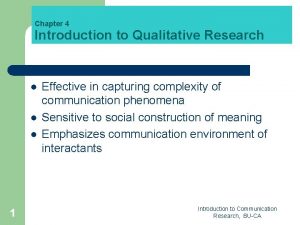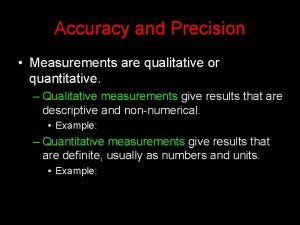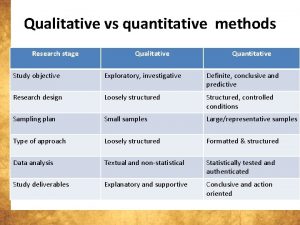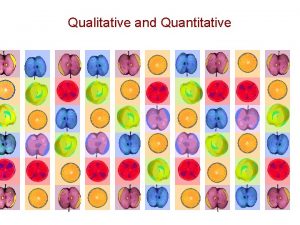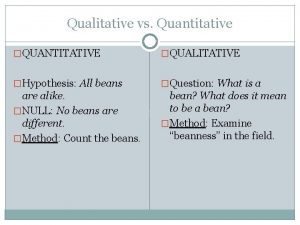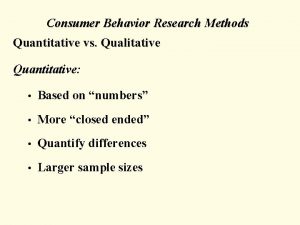Integrating qualitative with quantitative methods in health research











































- Slides: 43

Integrating qualitative with quantitative methods in health research: An introduction Margaret Cargo Douglas Hospital Research Centre Department of Psychiatry 27 April 2005

Defining ‘Mixed Methods’ A mixed methods study involves the collection or analysis of both quantitative and qualitative data in a single study in which the data are collected concurrently or sequentially, are given a priority, and involve the integration of the data at one or more stages in the process of research. Creswell, R. (2003). Research Design: Qualitative, Quantitative and Mixed Methods Approaches. 2 nd Edition. Thousand Oaks, CA: Sage.

Why? Provides a more complete picture of the research problem “Reaching the parts other methods cannot reach” Pope C, and Mays N. (1995)

Good science… • Adding a second method to a study does not necessarily make it good science • Need a strong rationale for mixing methods • Rigour in the collection and analysis of both qualitative and quantitative data – apply standards that are appropriate for each method

Research Design Components Research Purpose/ Questions Quantitative Relationship of researcher to the research Sampling Data Collection Data Analysis Qualitative

Research Design Considerations • Costly designs • Time consuming • Training and expertise required in both qualitative and quantitative research

Purposes for mixed-method research Development Complementarity Triangulation Initiation Understanding Explanation Internal Validity • Research question drives the choice and integration of methods • Consider the state of knowledge development in your field

QUAL methods used to DEVELOP QUAN measures Qualitative Quantitative • Results from one method used to help develop/inform the other method to increase the validity of constructs Results

Barrett F, Smith SC, Wellings K (2004). Conceptualisation, development and evaluation of a measure of unplanned pregnancy. Journal of Epidemiology & Community Health, 58, 426 -433. • To conceptualise, develop and validate a quantitative measure of unplanned pregnancy based on lay views that could be applied to any women in Britain • Sampling: purposive sample of women (n=47) with different pregnancy outcomes: – 1) continuing to term (n=28) and – 2) abortion (n=19); age range (15 to 43) • Two rounds of in-depth interviews: – 1) a main round with pregnant women; – 2) follow-up interviews after birth • Interviews were tape recorded • Data analysis: Theme analysis transcribed

Context Personal circumstances/timing: (timing in terms of relationship, stage in life, material resources, etc) Desire for pregnancy/ motherhood Stance Step 1: Partner influences: (agreement, desire for pregnancy) Relationships between dimensions may or may not be congruent Expressed intentions: (positive intentions, ambivalent intentions, no positive intentions) - Conceptual model of pregnancy planning/unplanned pregnancy Pre-conceptual preparations (for example, folic acid, seeking health advice etc) Contraceptive use: (non-use, partial use, consistent use, method failure) Behaviour - 6 themes

Step 2: - Conceptual framework used to inform item development until all dimensions were represented Step 3: - Items piloted with 26 women. Qualitative interviews used to check women’s understandings Step 4: - Instrument was field tested with two groups (n=390; n=651 women): Ø Test-retest reliability (0. 97) Ø Internal consistency (0. 92) Ø construct validity. . .

Assessing construct validity… Hypotheses based on qualitative research: ü Higher scores (0 -12) were associated with continued pregnancies and lower scores were associated with pregnancies ending in abortion ü Higher educational status was associated with higher scores Hypothesis from the literature: ü Black women had lower scores

A new psychometrically validated measure of unplanned pregnancy is available for use Final scale = 6 -items (one item from each dimension in the conceptual model)

Complementarity Ø Each method carries a different, but complementary function Ø Results from one method are used to elaborate, illustrate or clarify the results of the other method Ø To increase meaningfulness, interpretability and validity of the study One method is dominant or each method is equally influential 3 possibilities for integration

a. QUAL methods used to support QUAN component QUANTITATIVE Results Qualitative § § § can assist with exploring certain results in more detail can assist in explaining and interpreting unexpected results can assist with understanding a study component less amenable to quantitative methods (e. g. emic experiences with an intervention)

Bradley F, Wiles R, Kinmonth A-L, Mant D, Gantley M, for the SHIP Collaborative Group (1999). Development and evaluation of complex interventions in health services research: case study of the Southhampton heart integrated care project (SHIP) BMJ, 318, 711 -5. QUANTITATIVE A pilot RCT designed to assess the impact of a program on lifestyle and CV risk in myocardial infarction/angina patients Results Qualitative To understand how the intervention was delivered: Ø patients interviewed at hospital discharge + 3 months later Ø interviews with nurse practitioners

Barrett F, Bradley F, Wiles R, Kinmonth A-L, Mant D, Gantley M, for the SHIP Collaborative Group (1999). Development and evaluation of complex interventions in health services research: case study of the Southhampton heart integrated care project (SHIP) BMJ, 318, 711 -5. • Qualitative study nested within a pilot RCT • Intervention promoted the adoption of a healthy lifestyle (behaviour change) and made service provisions for continuity of care • Participant Sampling: maximum variation – – Patients interviewed just after hospital discharge @ 3 months (n=25) Practitioners (hospital and practice nurses) interviewed or participated in a focus group (n=22) • Semi-structured interview guide • Interviews tape recorded - transcribed • Thematic analysis (“grounded theory approach”)

Quantitative Results… • No significant differences between the intervention and control groups on any of the primary outcome measures of CV risk • Increased FU at general practice at 4 months and 12 months in the TMT group • Improved attendance for rehabilitation in the TMT group

Qualitative Results… • Nurses require more training to deliver the intervention (lacked knowledge and skills) • Patients lost faith in the information given by practitioners when the recovery experience was inconsistent with that information • Patients questioned whether changing their lifestyle would protect them from another heart attack. . . so why change their behaviour?

Integrating qualitative and quantitative methods in a pilot RCT “formalises the usually hidden learning curve of implementation and optimisation”

b. QUAN methods used to embellish (support) a primarily QUAL study QUALITATIVE Results Quantitative § Less common in medical and epidemiological research § More common in social and preventive medicine and nursing research

c. QUAL and QUAN methods used equally and in parallel Qualitative Results Quantitative Starting to become more common in medical/ epidemiological research e. g. evaluation of community-based prevention programs - quasiexperimentation (lack of control group, difficulties with random assignment)

Hawe P, Shiell A, Riley T, Gold L. (2004) Methods for exploring implementation variation and local context within a cluster randomised community intervention. J Epidemiology Community Health § To understand how local context influences implementation of a community-based strategy to promote maternal health after childbirth to reduce postnatal depression § 8 intervention communities § FT community development officer in each community working with a local steering committee § Intervention: professional education and development for practitioners and maternal/ child health nurses + information kit for mothers + strategies to create mother friendly environments

Hawe P, Shiell A, Riley T, Gold L. (2004) Methods for exploring implementation variation and local context within a cluster randomised community intervention. J Epidemiology Community Health Qualitative - narratives with fieldworkers to understand factors influencing program implementation over time (n=8) - key informant interviews from community stakeholders (n=30 in each of 8 communities = 240) Results Quantitative - inter-organisational network surveys within communities (e. g. density of ties) - track # of activities and events implemented

QUAL and QUAN methods are combined to INITIATE a new perspective Qualitative Results Quantitative Ø Aims to uncover “paradox” or contradiction, new perspectives or frameworks; recasts questions or results from one method with questions or results from the other method Ø Challenges the status quo

Barroso, J and Sandelowski, M (2001). In the field with the Beck Depression Inventory. Qualitative Health Research, 11, 491 -504. Ø use of the BDI was problematic in a study of fatigue in HIV-infected persons (n=31) Ø Qualitative study documented problems with the BDI Beck Depression Inventory… § Most commonly used depression measure with HIV subjects § Current form - BDI-II, 21 items/ self-report for severity of depression in adults and youth § Advantages: good psychometrics, specificity in differentiating between depressed and nondepressed people § Used in 2000+ studies/ translated into many languages

QUAL and QUAN methods are combined to INITIATE a new perspective Interview - describing fatigue and experiences that might be relevant to fatigue, depression and problems with sleeping; Observations Qualitative Results Quantitative Administered Beck Depression Inventory (BDI) (n=31)

Some problems with the BDI-II … one man noted that to respond to the item “I cry more than I used to” by saying yes would not mean that he was depressed. As he explained it, although he did cry more than he used to, it was not because he was depressed but rather because he had become more in touch with his feelings as a consequence of his encounter with HIV infection (pg. 498)

… most of the items on the BDI-II refer to how things “used to be”; however, the instructions advise the respondent to circle the statement that best describes how they have been feeling during the past 2 weeks, including the day on which they are responding to the test. For people with HIV infection, life is often divided into before and after infection and/or diagnosis; how things used to be is how they were before becoming infected or learning of their infection. . . the way things used to be may not correspond to the past 2 weeks.

Congruence of interview data with BDI-II inventory score Depressed: BDI Not depressed: BDI Depressed on interview 12 5 Not depressed on interview 7 7

Difficult to preserve meaning and reduce meaning in the context of a single study “Instruments require continuous qualitative, in addition to quantitative assessment” Potential problem: the population on which the BDI was normed (psychiatric outpatients and college students) vs the study population (minority groups, low SES, living in rural areas, highly stigmatized and disenfranchised)

QUAL and QUAN methods are TIANGULATED to enhance internal validity Results Quantitative Results from different methods used for corroboration and convergence Qualitative

Campbell R, Quilty B, Dieppe P. (2003). Discrepancies between patients’ assessment of outcome: qualitative study nested within a randomised controlled trial. BMJ, 326, 252 -253. • RCT tested the effectiveness of a package of physiotherapy TMT for patellofemoral osteoarthritis • Nested qualitative study included 20 participants randomized to the intervention arm • Provided an opportunity to compare qualitative and quantitative approaches in collecting outcome data

Campbell R, Quilty B, Dieppe P. (2003). Discrepancies between patients’ assessment of outcome: qualitative study nested within a randomised controlled trial. BMJ, 326, 252 -253. Results Quantitative Qualitative - Self-reported pain in worse knee - 10 cm visual analogue scale - in-depth interviews after the TMT, but before main follow up of the trial - function subscale of WOMAC, validated disease-specific osteoarthritis index - conducted in patent’s homes, guided by a checklist of topics

Pain scores on questionnaire and interview Questionnaire Interview Better No Change Worse Total Better 6 1 2 9 No Change 7 2 1 10 Worse 1 0 0 1 Total 14 3 3 20 Concordance between survey and interview data was less than 50%

“. . . the investigators agreed completely on the interpretation of the interview data” Explanation for the discrepancy - context in which the data was collected: Ø QUAL information obtained from an interviewer (non-healthcare professional) in the patient’s home Ø QUAN data obtained in the trial clinic in the presence of a doctor

Sequential Designs A. Sequential Explanatory Designs QUAN qual Results B. Sequential Exploratory Designs QUAL quan Results

C. Three (or more) part sequences Establish Psychometrics QUAL QUAN Develop conceptual framework Results QUAN Establish construct validity

Concurrent Research Designs D. Concurrent Triangulation Design QUAL + QUAN Data collected at the same time and the results are compared

Concurrent Research Designs D. Concurrent Nested Design (qualitative nested within a predominant quantitative study) qual QUAN Analysis of findings

Concurrent Research Designs E. Concurrent Nested Design (quantitative nested within a predominant qualitative study) quan QUAL Analysis of findings

Summary • strong rationale for integrating methods • research question drives the integration • ensure rigour in the collection and analysis of both types of data • can be time consuming and costly • requires expertise in both methodologies • has potential to strengthen knowledge claims • promotes consumer involvement • can facilitate knowledge translation

 Integrating qualitative and quantitative methods
Integrating qualitative and quantitative methods Sampling methods in qualitative and quantitative research
Sampling methods in qualitative and quantitative research How to collect data in quantitative research
How to collect data in quantitative research Qualitative quantitative
Qualitative quantitative Similarities between qualitative and quantitative research
Similarities between qualitative and quantitative research Similarities between qualitative and quantitative research
Similarities between qualitative and quantitative research Limitations of qualitative research
Limitations of qualitative research Quantitative emphasis
Quantitative emphasis Thematic analysis in qualitative research
Thematic analysis in qualitative research Qualitative research methods in political science
Qualitative research methods in political science Quota sampling in qualitative research
Quota sampling in qualitative research Visual methods in qualitative research
Visual methods in qualitative research Qualitative research methods
Qualitative research methods Individual interview in research
Individual interview in research Research methodology
Research methodology Qualitative research methods
Qualitative research methods Integrating public health and primary care
Integrating public health and primary care Research paper appendices example
Research paper appendices example Components of chapter 3 in research
Components of chapter 3 in research Purpose of qualitative research
Purpose of qualitative research Qualitative data geography
Qualitative data geography What is holistic approach in research
What is holistic approach in research Longitudinal study qualitative or quantitative
Longitudinal study qualitative or quantitative Si unit in science
Si unit in science Who is pictured above?
Who is pictured above? Qualitative vs quantitative biology
Qualitative vs quantitative biology Is a telephone number quantitative or qualitative
Is a telephone number quantitative or qualitative Quantitative and qualitative data difference
Quantitative and qualitative data difference Definition of qualitative and quantitative observations
Definition of qualitative and quantitative observations Diffrence between qualitative and quantitative
Diffrence between qualitative and quantitative Qualitative variables and quantitative variables
Qualitative variables and quantitative variables Qualitative differenzierung
Qualitative differenzierung Density
Density Quantitative data vs qualitative data comparison
Quantitative data vs qualitative data comparison Qualitative vs quantitative sociology
Qualitative vs quantitative sociology In a survey of 177 237 u.s. adults
In a survey of 177 237 u.s. adults Types of quantitative variables
Types of quantitative variables Precision of measurement depends on *
Precision of measurement depends on * Words images objects qualitative or quantitative
Words images objects qualitative or quantitative Quantitative and qualitative traits
Quantitative and qualitative traits Qualitative traits vs quantitative traits
Qualitative traits vs quantitative traits Quantitative test for lipids
Quantitative test for lipids What is qualitative observation
What is qualitative observation Qualitative traits vs quantitative traits
Qualitative traits vs quantitative traits





